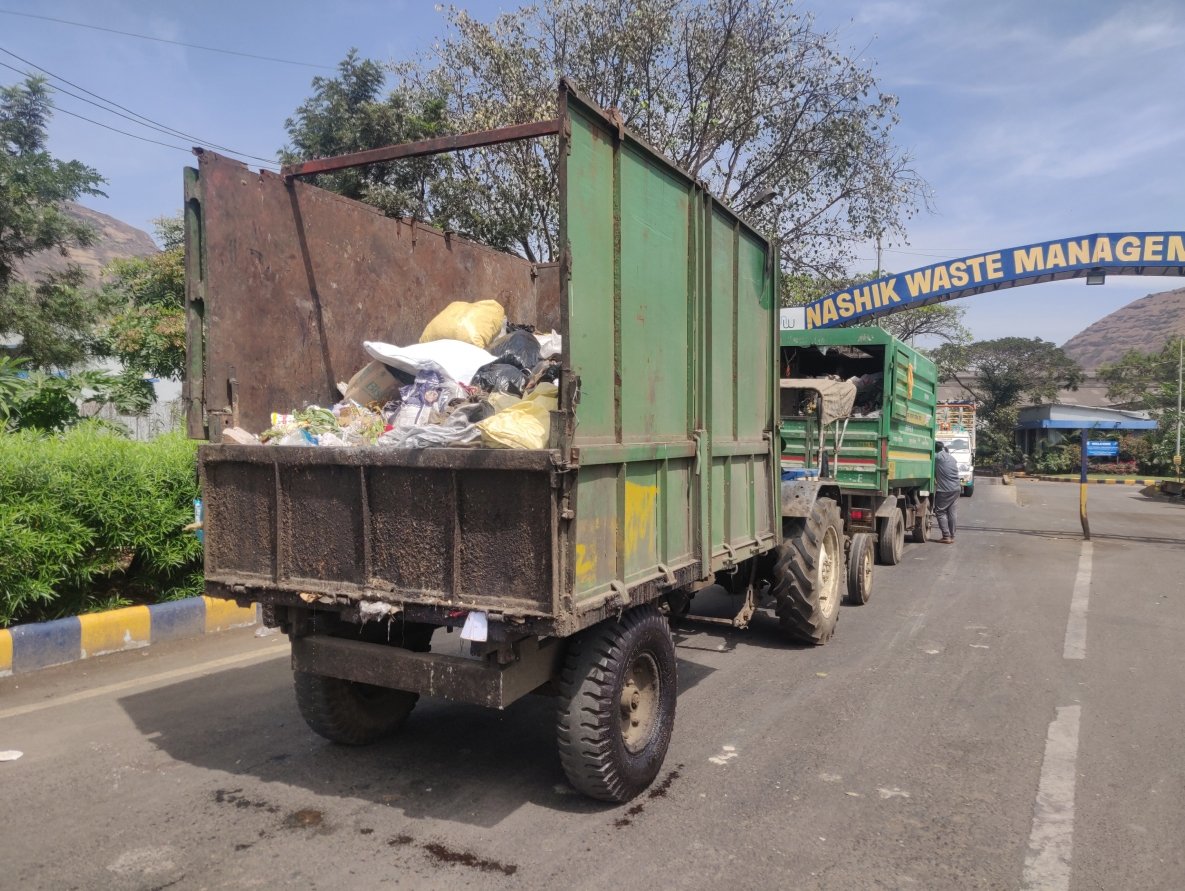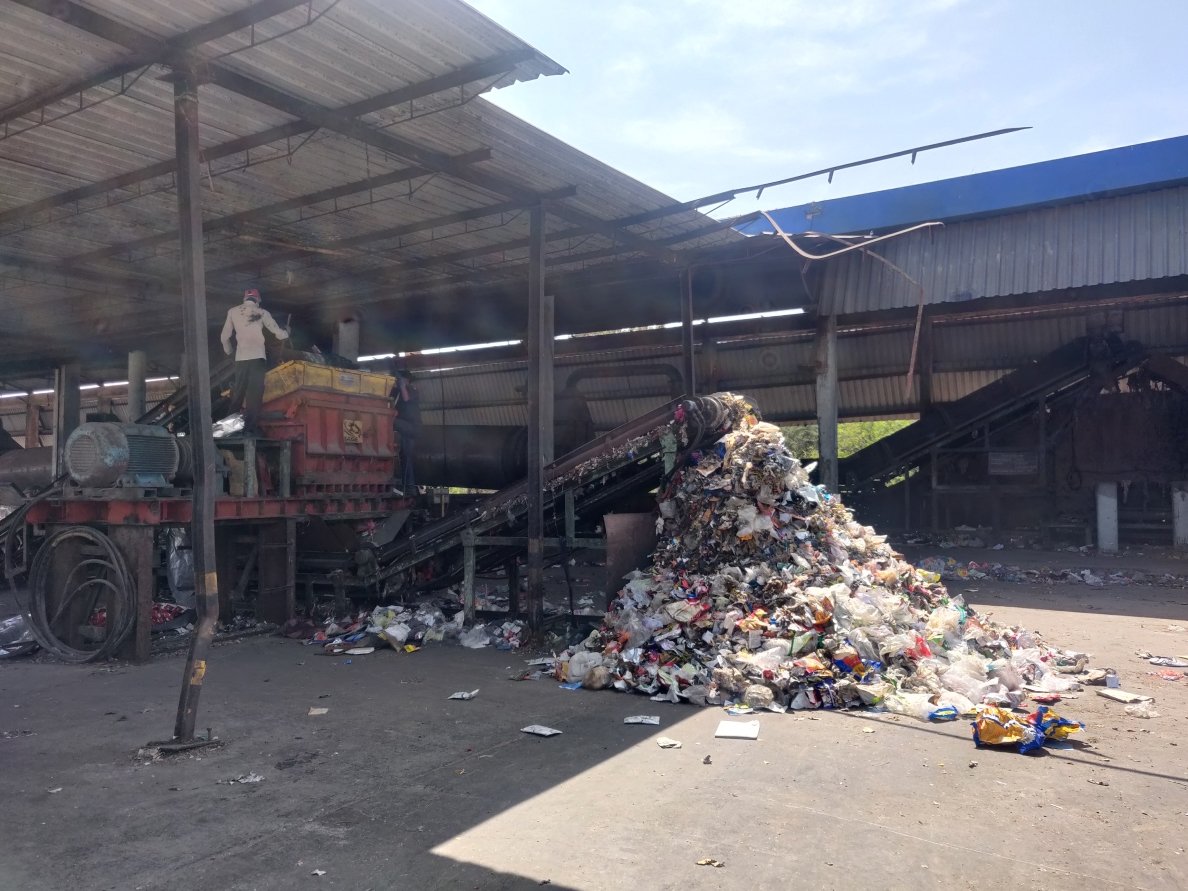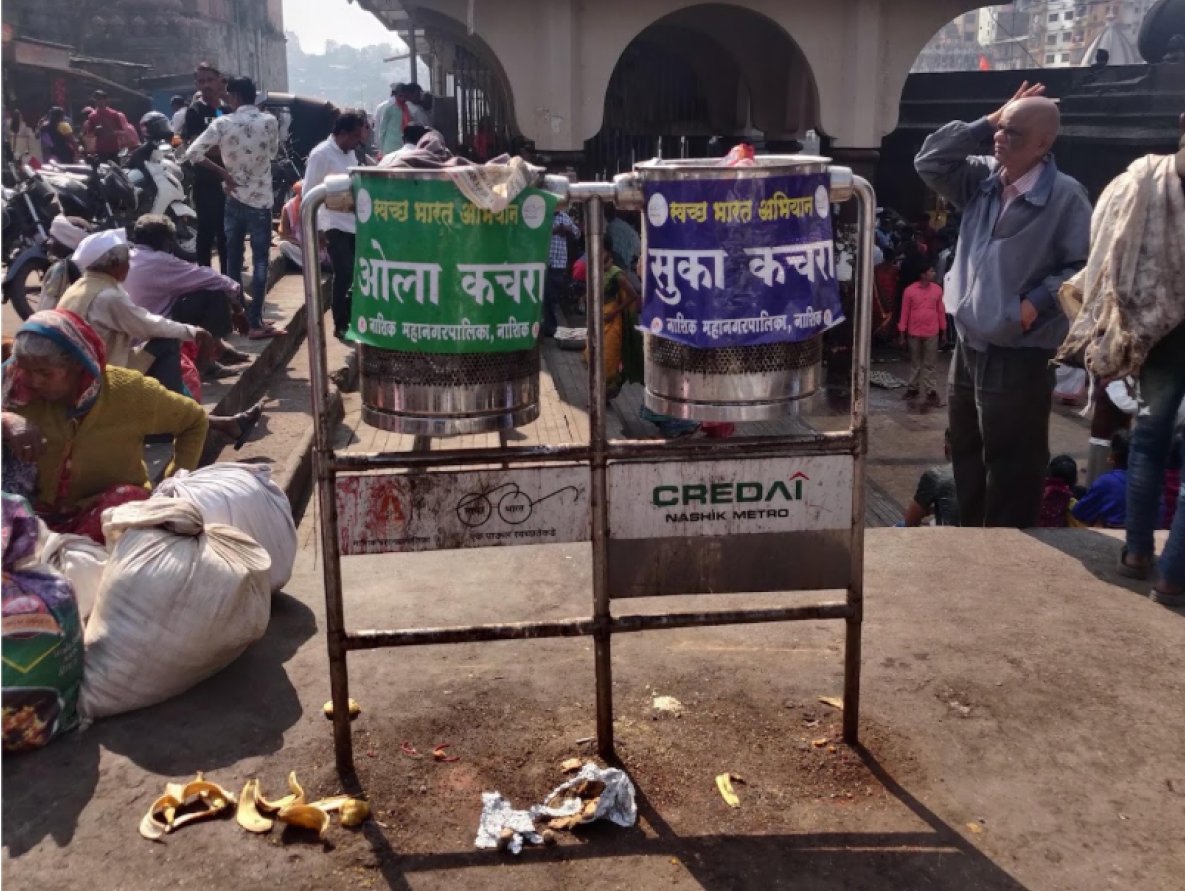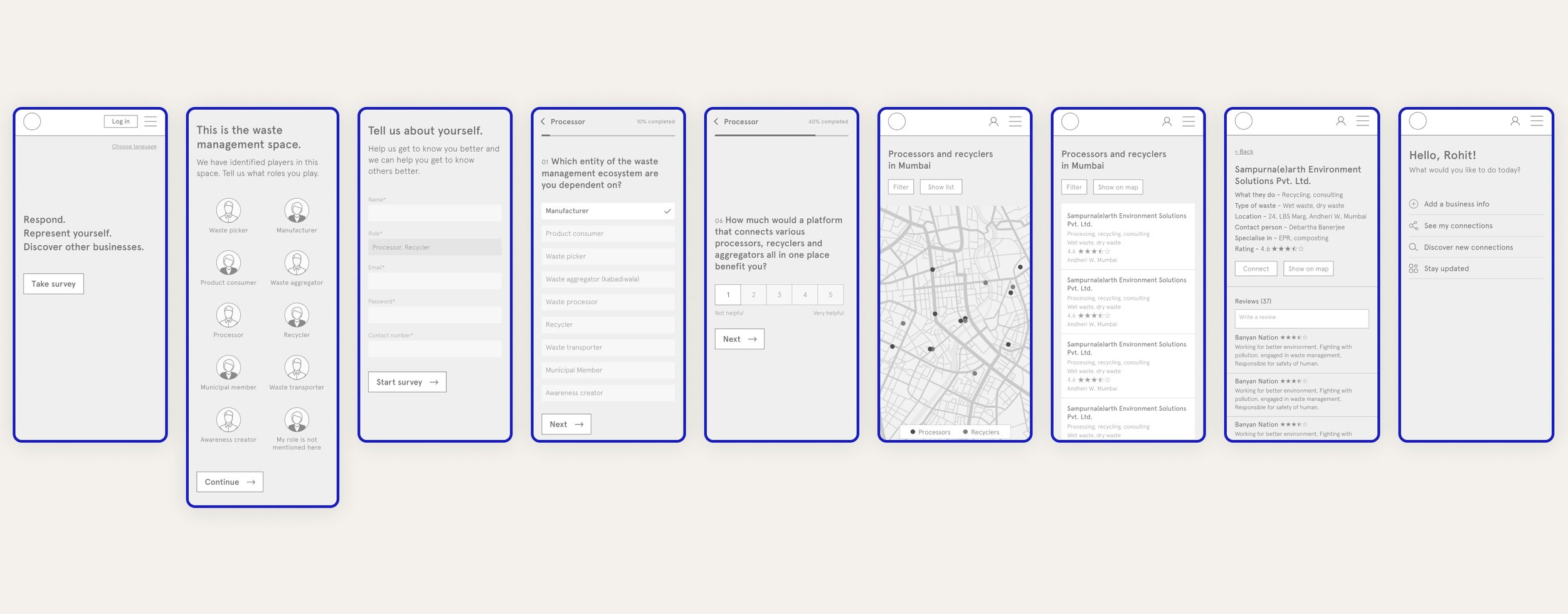Social innovation in the waste management sector
Team
3 engineers, 1 designer (me)
Duration
5 months
My role
UX-UI designer for end-to-end process: discovery, research, conceptualization, wireframing, visual design, prototyping and testing.
Methodologies
Personal interviews, focus group discussion, observational studies, social experiments
India is getting buried under mounds of garbage as the country is generating 62 million tonnes of waste annually. By 2030, it is estimated to increase to 163 million tonnes of waste a year.
Out of the municipal waste collected, only 22-28% of it is processed and treated. The rest 72-78% of waste ends up in landfills. Several organisations are focussing on acquiring the waste before they reach landfills so that it can be efficiently processed and disposed off soundly. However, with the growing population of the country, the waste management issue will only get increasingly challenging.
Overview
Waste journeyThe waste management sector has a plethora of problems and opportunity areas that we could intervene in. During the secondary research, we mapped what the ecosystem looks like, who the players are and how do each of these groups impact the supply chain, indicating how they are all mutually connected and inter-dependent. From various government reports on waste models and global innovations to Indian laws, we studied about waste and its economics.
Exploring the waste terrain
ecosystem mappingPrimary research
Social experiment
We conducted a social experiment at the tea stall in front of our workplace. The stall was a low maintenance, low effort setup that was visibly struggling to manage the waste they were generating. The dustbins were makeshift and not at all efficient in serving their purpose. People were throwing trash everywhere around the place because the dustbins were already overflowing.
In order to observe human behavior and test if clearly marked signs will help the situation, we created separate dustbins for different waste types from cardboard boxes and scrap paper, and placed them in visible areas while also educating the shopkeepers about the effects of untreated waste. We also talked to customers to understand their waste management habits while observing their reactions to the experiment. The dustbins alleviated the issue of waste sorting at source and the shopkeeper noticed a change in the customers’ behaviour.
Field research
We did extensive field research in a variety of places including marketplaces, malls, transit hubs and ghats. We interviewed various waste management organisation representatives to understand their journey in this sector, their observations and opportunity areas that they think are still to be tackled. A trip to the Nashik Waste Management Plant opened our eyes to the ground reality of municipal waste. We saw the processes of collection, sorting, and processing. Seeing a real landfill outside of the city opened our eyes to the gravity of the waste problem.




Stakeholder insights
“Waste changes with demography, so the government should carry out proper R&D and not copy-paste the tech being used in other countries.”
— Dr Pratibha Ganesan, Assistant Professor at TISS
“Consumers should also be made responsible for the waste they are generating. ECR - Extended Consumers Responsibility, like EPR.”
— Sunny Gangar, Business Administrator at
RUR Greenlife
“We are only able to process 20% of solid waste. Rest all is dumped in the landfills.”
— Patharde Saheb, Site Manager at Nashik Waste Management Plant
“I am unable to collect the volume of material that I have the capacity for. And whatever I do get is not of good quality.”
— Rahul Pandey, Plastic Waste Aggregator
“100% segregation means 100% recycling.”
— Amita Deshpande, Founder of Aarohana
“All entities have to come together to solve this problem, starting from homes to big manufacturers.”
— Sahar Mansoor, Founder of Bare Necessities
“Be like an Uber to recyclers and collectors- a bridge between different entities.”
— Debartha Banerjee, Founder of Sampurn(e)arth
Data synthesis
After conducting interviews, going on field visits and creating journey maps, it was time to put all the insights gathered on sticky notes and look for patterns. These patterns gave us several themes and potential opportunity areas where we could intervene.
affinity mappingThe momentum of the project was decelerated due to the sudden lockdown brought on by the onset of the COVID-19 pandemic in April 2020. Waste management is an area that largely needs physical presence on the ground in order to get a lay of the land but we then had to resort to alternative methods of research and collaboration. Meetings with stakeholders were moved online which meant that we’d miss out on interacting with stakeholders who are mostly in the field and not tech savvy. On the other hand, the situation also gave us an opportunity to understand and observe how waste was being handled in our respective households and cities.
The pandemic
Opportunity areas
1.
Tracing a product from its cradle to grave and an audit of how its affecting the environment
2.
Monitoring the ways of Waste Segregation
3.
Not even 5% of the wet waste produced in the cities is composted and instead ends in dumping sites because of lack of market to sell
4.
Visibility among the various entities working in the space
The final area of intervention is the problem of lack of visibility between entities in the WM ecosystem.
There are innumerable players in this space but most of them are unaware of each other’s presence. It is not efficient for the players in this sector to work in silos. Entities are directly or indirectly dependent on each other for material, technology and even information. The system is strained with several irregularities in the chain. For the system to be coherent and operate like a well oiled engine, there has to be transparency and visibility.
How can a waste producer contact a waste collector? How can waste pickers collect maximum material in order to make sufficient livelihood? Which processor should a waste collector sell his material to? Which manufacturer needs the collected material in order to comply with the EPR laws?
Area of intervention
How can the different players and entities in the waste management ecosystem be made visible to each other so as to allow for the passage of information leading to more communication, more recycling and eventually diverting waste away from landfills?
Problem statement
Visibility among all the players in the ecosystem
Visibility about the available waste and its dealers
Visibility on the prices, quality and information
Visibility on the laws of waste management
Visibility of the carbon footprint during the journey of waste
What would visibility look like?
Ideation and solution
The solution to the problem statement should address and cater to:
Allowing for exchange of information and/or services
Making it easy to locate entities in the Waste Management sector
Transparency and accountability in the system
A mindset of co-creation of the platform with the users
The final solution was to create a collaborative research tool in the form of an online platform for waste management players and businesses to put themselves on the map, be seen by others and build a meaningful network.
It connects manufacturers, consumers, aggregators, and recyclers enabling better flow of material and information in the system. In this way, each group has visibility on which other entities are in their vicinity, enabling them to connect and carry out business. The issue of consumers not finding collectors, or aggregators not finding recyclers will be resolved when everyone in the ecosystem is aware and connected with each other.
Data collection about the different stakeholders is the first step. This would be achieved by building an online research tool which would collect data through a questionnaire while onboarding the players onto the platform. All this data would be pooled together to create a personalised experience for each user.
After the initial onboarding, the user would be able to connect with different entities and build a community. Users will also be encouraged to add any organisations or entities that they are connected to offline. This would keep the network thriving and more players would be added, making them visible to multiple other businesses and entities.
The platform will allow manufacturers and producers to achieve their EPR targets. Regulated and verified pricing will ensure that each member gets a fair deal. By putting themselves on the map, each individual, aggregator and organisation can make themselves available to the trade of waste and grow their respective networks.
Connecting people is the first step. Once that has been achieved successfully, a feature of transactions between them can be enabled. This would ensure that the interactions between them become traceable and accountable.
Impact
Waste is a commodity— a product one can buy and sell. That is what the platform could be used for. Over time, the network could become self-sustainable, being run by users, for the users. The social impact that this solution could bring is:
Recognising the informal sector by onboarding them on our platform and providing them connections and opportunities
As more waste is channeled to recyclers, the load on our landfills as well as the carbon footprint would reduce
Allowing for traceability of waste, ensuring people that their effort of segregating the waste has not gone in vain
Create awareness and help companies comply with the rules laid out by the government in waste sector
On a personal level, this project gave me an opportunity to collaborate with people from different disciplines and backgrounds. Until this project came along, I was designing for smaller problems and product-specific briefs but with this experience, I got to work on a problem that is a serious issue for India and also affects the whole world. It taught me how problems in the real world don’t come in neat packages. They are complex and multi-variable. It developed my sense of empathy and a human-centred design mentality while also helping destigmatize this topic.







